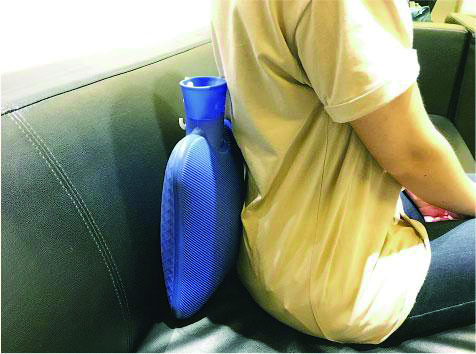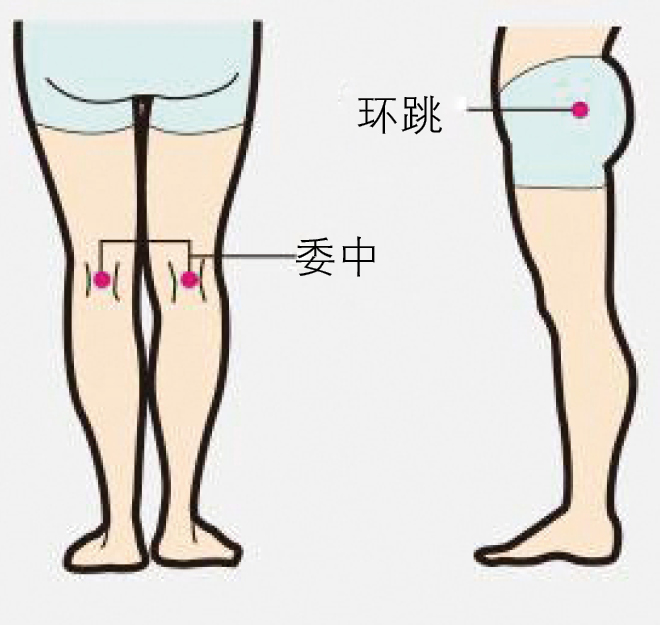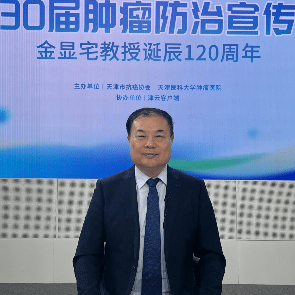Acupuncture, massage, straightening out Qi and blood, exercising, strengthening muscles, saying goodbye to back pain
[ad_1]
(Hong Kong News) Traditional Chinese medicine treats low back pain by reviewing the pathogenesis based on medical history and symptoms, and using Chinese medicine, acupuncture or massage techniques for syndrome-based treatment.
Pain when Qi and blood flow blocked
The onset of acute low back pain is relatively sudden. Patients often feel tightness and pain in the waist, which affects daily activities, especially in bending, turning around or getting up in the morning. In addition, there should be no symptoms of paralysis of the lower limbs, fever, or incontinence.
The cause of acute low back pain is, on the one hand, due to injury, such as sudden hyperextension, hyperflexion, bending over to lift heavy objects, or sudden setbacks when falling down, etc.; Wind-cold-damp pathogens attack the meridians, obstructing the flow of Qi and blood, causing pain if it is blocked, and it is also a common cause of acute low back pain.
Pathologically, patients with acute low back pain often have tightness, swelling, and pulling pain in the waist muscles, which are mostly caused by muscle tension and inflammation. As for lesions involving spinal structures such as lumbar disc herniation, it is not common in clinical practice. It is helpful to diagnose by taking medical history, palpation, functional examination, imaging examination (such as taking X-ray) and other means.
Avoid hot compresses for acute lumbar injuries
Traditional Chinese medicine understands that acute low back pain is mostly a syndrome. In terms of treatment, it should dispel wind and cold dampness, activate blood and dredge collaterals. Commonly used traditional Chinese medicines include Duhuo, Clematis, Gentiana, Atractylodes, Poria, and Fangfeng. Those who are injured and stasis block the meridians can see fixed lumbago, distending pain, refusal to press, and ecchymosis may be seen on the skin surface. Angelica, peach kernel, safflower, myrrh, etc. can be used together to promote blood circulation, remove blood stasis, reduce swelling and relieve pain.
In terms of acupuncture and moxibustion, it is generally possible to select acupoints near the affected area, combined with electroacupuncture stimulation, and cupping can be added for rheumatism or cold-damp low back pain. The course of treatment for acute low back pain generally ranges from a few days to a few weeks.
In the early stage of acute lumbar injury, it is not advisable to use strong massage techniques, and avoid hot compresses, so as not to aggravate inflammation and swelling.
Patients can use cold compresses to relieve pain and reduce swelling in the first two days after the injury. After 48 to 72 hours after the injury, when the swelling of the affected area does not continue to worsen, they can change to hot compresses to promote blood circulation and speed up recovery. At this time, patients can also cooperate with massage techniques such as pressing, kneading, pushing, and rubbing to stimulate the affected area and surrounding soft tissues, relax muscles, and promote the circulation of Qi and blood.
Insufficient righteousness and recurrent illness
Chronic and recurrent low back pain is mostly related to strain and degeneration. Patients may feel pain, fatigue, and heaviness in the waist. The condition may be aggravated by exercise, labor, or sitting for a long time. It can be temporarily relieved after rest or a little stretching.
The traditional Chinese medicine pathogenesis of chronic low back pain is mostly a mixture of deficiency and excess. There are not only liver and kidney insufficiency, weak Qi and blood, which affect the weakness of bones and muscles, but also fatigue and injury that lead to Qi stagnation and blood stasis, or lack of activity that leads to poor circulation of Qi and blood. The factors of smoothness and blocked meridians can influence each other.
Insufficient qi and blood will lead to weak movement of qi and blood and aggravate stasis. Repeated exertion will not only increase the burden on muscles, bones and joints, but also excessively consume qi and blood, resulting in exhaustion and repeated low back pain.
The traditional Chinese medicine treatment of chronic low back pain usually focuses on consolidating the root and nourishing the essence, nourishing the liver and kidney, strengthening the muscles and bones, supplemented by promoting the circulation of qi and blood, dispelling wind and cold dampness, and eliminating stagnation of qi and blood stasis. The tonic traditional Chinese medicines commonly used to treat chronic low back pain include Morinda officinalis, Dipsacus, Eucommia, Gouji, and Spatholobus, etc. Chinese medicine prescriptions such as Duhuo Jisheng Decoction.
For the symptoms of low back pain, clinically, drugs for improving acute low back pain can be selected on the basis of consolidating the foundation, and used together to eliminate pathogenic factors and strengthen the body.

Longer course of treatment for chronic low back pain
Acupuncture and moxibustion treatment of chronic low back pain can not only select the acupoints near the affected area, but also cooperate with the acupoints that nourish the liver and kidney and strengthen the muscles and bones, such as Shenshu, Dachangshu, Yaoyangguan on the back, Weizhong and Kunlun on the lower limbs. If the waist and buttocks often have recurring pain, which affects leg raising movements such as going up and down stairs, you can choose Zhibian and Huantiao points located on the buttocks.
The treatment of chronic low back pain can generally be combined with hot compresses, moxibustion and other warm stimuli to relax muscles and promote blood circulation. The effect of massage manipulation in treating chronic low back pain is mainly to relax the psoas muscles and other soft tissues, correct dislocations, and straighten out Qi and blood. Since the course of treatment for chronic low back pain is relatively long, patients need to be patient and persistent.


Acupuncture improves low back pain
Shenshu: below the spinous process of the second lumbar vertebra, 1.5 cun lateral to the left and right
Dachangyu: below the spinous process of the fourth lumbar vertebra, 1.5 inches laterally to the left and right
Yaoyangguan: on the posterior midline of the body, in the depression under the spinous process of the fourth lumbar vertebra
Central: midpoint of the popliteal crease behind the knee
Ring jump: outside of the buttocks, on the line connecting the most protruding point of the greater trochanter of the femur and the hiatus of the sacral canal (see picture)
Operation method: Acupuncture, warm moxibustion or massage each acupoint for 5 to 10 minutes, until there is a feeling of soreness, numbness and swelling, once a day
3 ways to relax muscles and reduce strain
1. Maintain correct posture to avoid injury or strain
When lifting heavy objects, keep your waist straight and your legs squatting down, use your lower limbs to exert strength, and avoid bending over. When sneezing or coughing, avoid throwing your body forward suddenly, and be careful not to slip your waist. Standing up after sitting for a long time, and getting up in the morning should not be too hasty, and the force should not be too strong. Do not sit in a chair that is too soft, and do not sleep on a bed that is too soft.
If you need to sit for a long time, you should use a back cushion to protect your waist. When sitting or standing, keep the waist naturally straight, but do not deliberately lean forward or backward to maintain the physiological curvature of the lumbar spine and reduce lumbar muscle strain.
2. Avoid blowing directly on the waist to catch the cold
If the psoas muscles feel the wind and cold, they will tighten and contract, hindering blood circulation. When the weather is cold, use a hot water bag, warm pack, etc. to apply heat to the waist, for 20 to 30 minutes each time, 1 to 2 times a day, to relax the lumbar muscles and promote blood circulation.
Blowing with a hair dryer, showering with hot water, etc. usually only irritate the surface of the skin and cause a burning sensation, but the heat may not penetrate deep into the muscles to relax the muscles, so these methods are not encouraged to replace hot compresses.
3. Do exercises to exercise the lower back
Swimming, sit-ups, yoga stretching or traditional Chinese health exercises such as Yi Jin Jing and Tai Chi can improve the strength and flexibility of the waist muscles and reduce the risk of strain and injury.
Text Qiu Yufeng (Chinese Medicine Physician)
 Understand the warning signs of low back pain disease at once
Understand the warning signs of low back pain disease at once
Back pain, how to do? What are the causes of sudden low back pain?
It turns out that low back pain may be caused by kidney disease, herniated intervertebral disc, or muscle strain. Let me teach you how to judge from the location of low back pain.
Low back pain is medically called lower back pain, and the pain area is from below the thoracic spine to between the buttocks, that is, the range of the lumbar spine.
The lumbar spine supports the weight of the upper body and provides mobility for daily movement. Whether it is bending to pick up something or turning around, the contraction and relaxation of the lumbar muscles are required.
Distinguishing disease types from location
The location of low back pain is helpful for diagnosis:
◆Left and right low back pain may be a sign of kidney problems, and the location of the pain can be used to determine whether there is an abnormality in the left or right kidney.
◆Low back pain on the right side can also be caused by gallstones and cholecystitis.
◆Lower back pain is mostly caused by injuries to the back muscles, ligaments and lumbar spine.
In addition to distinguishing the type from the location of low back pain, the type of disease can also be judged from the way the low back pain manifests.
If the low back pain is triggered by bending or twisting, it may be due to flashing to the waist, muscle or ligament injury, or intervertebral disc herniation. Pain at rest has a higher chance of systemic inflammation (ankylosing spondylitis, lupus, or rheumatoid arthritis) or cancer.
Text You Yikai “Healthy”
[ad_2]
Source link

![[Love Wants Sexual Happiness Series 358]Find the culprit and overcome psychogenic erectile dysfunction. Don’t let pressure affect your sexual happiness.](https://chinathenews.com/wp-content/uploads/2024/04/171111-780x420.jpg)

![[Wanqingyi Care]My health, my rights, customized medical methods in the last stage of life](https://chinathenews.com/wp-content/uploads/2024/04/ZZ1-100-780x420.jpg)
![[Kidney Transplantation Special Topic]The survival rate of transplanted kidneys is high without dialysis treatment three times a week](https://chinathenews.com/wp-content/uploads/2024/04/1311-780x420.jpg)



